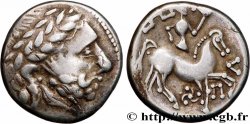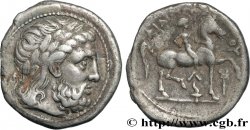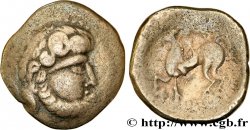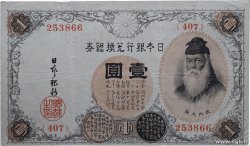v34_1314 - DONAURAUM Tétradrachme “au rameau”
MONNAIES 34 (2008)
Startpreis : 950.00 €
Schätzung : 1 500.00 €
Erzielter Preis : 1 200.00 €
Anzahl der Gebote : 2
Höchstgebot : 1 381.00 €
Startpreis : 950.00 €
Schätzung : 1 500.00 €
Erzielter Preis : 1 200.00 €
Anzahl der Gebote : 2
Höchstgebot : 1 381.00 €
Type : Tétradrachme “au rameau”
Datum: (IIe-Ier siècles avant J.-C.)
Metall : Silber
Durchmesser : 25,5 mm
Stempelstellung : 1 h.
Gewicht : 14,03 g.
Seltenheitsgrad : R2
Kommentare zum Erhaltungszustand:
Magnifique exemplaire, avec une frappe parfaite tant au droit qu’au revers. Fine patine grise, très légèrement irisée
N° im Nachschlagewerk :
Vorderseite
Titulatur der Vorderseite ANÉPIGRAPHE.
Beschreibung Vorderseite Tête laurée de Zeus à droite ; grènetis.
Rückseite
Beschreibung Rückseite Cavalier au pas à droite, tenant une palme de la main droite ; le cheval lève l'antérieur à droite ; entre les jambes du cheval, une torche.
Legende des Reverses : FILIP - POU
Kommentare
Si le statère d’or de Philippe II de Macédoine a servi de prototype à de nombreuses imitations gauloises, le tétradrachme n’a pas été imité en Gaule, mais reste principal sujet d’inspiration des monnaies pour les Celtes du Danube (LT. 9697-9767, 9768-9832, 9618-9630, 9870-9886). Les premières imitations furent frappées dans le premier quart du IIIe siècle avant J.-C. La fabrication des copies serviles, puis des imitations, enfin des frappes celtiques continuèrent pendant plus de deux siècles.
Au revers la torche correspond à Philippe III pour Amphipolis entre 323 et 316. Cet exemplaire est d’un très bon style, encore très proche du prototype.
While the gold stater of Philip II of Macedon served as a prototype for many Gallic imitations, the tetradrachm was not imitated in Gaul, but remains the main source of inspiration for coins for the Danube Celts (LT. 9697-9767, 9768-9832, 9618-9630, 9870-9886). The first imitations were struck in the first quarter of the 3rd century BC. The manufacture of servile copies, then imitations, and finally Celtic strikes continued for more than two centuries. On the reverse, the torch corresponds to Philip III for Amphipolis between 323 and 316. This example is of a very good style, still very close to the prototype
Au revers la torche correspond à Philippe III pour Amphipolis entre 323 et 316. Cet exemplaire est d’un très bon style, encore très proche du prototype.
While the gold stater of Philip II of Macedon served as a prototype for many Gallic imitations, the tetradrachm was not imitated in Gaul, but remains the main source of inspiration for coins for the Danube Celts (LT. 9697-9767, 9768-9832, 9618-9630, 9870-9886). The first imitations were struck in the first quarter of the 3rd century BC. The manufacture of servile copies, then imitations, and finally Celtic strikes continued for more than two centuries. On the reverse, the torch corresponds to Philip III for Amphipolis between 323 and 316. This example is of a very good style, still very close to the prototype








 Berichten über einen Fehler
Berichten über einen Fehler Die Seite drucken
Die Seite drucken Teilen meiner Auswahl
Teilen meiner Auswahl Stellen Sie eine Frage
Stellen Sie eine Frage Einlieferung/Verkauf
Einlieferung/Verkauf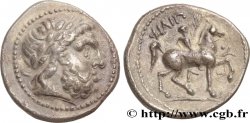
 Details
Details